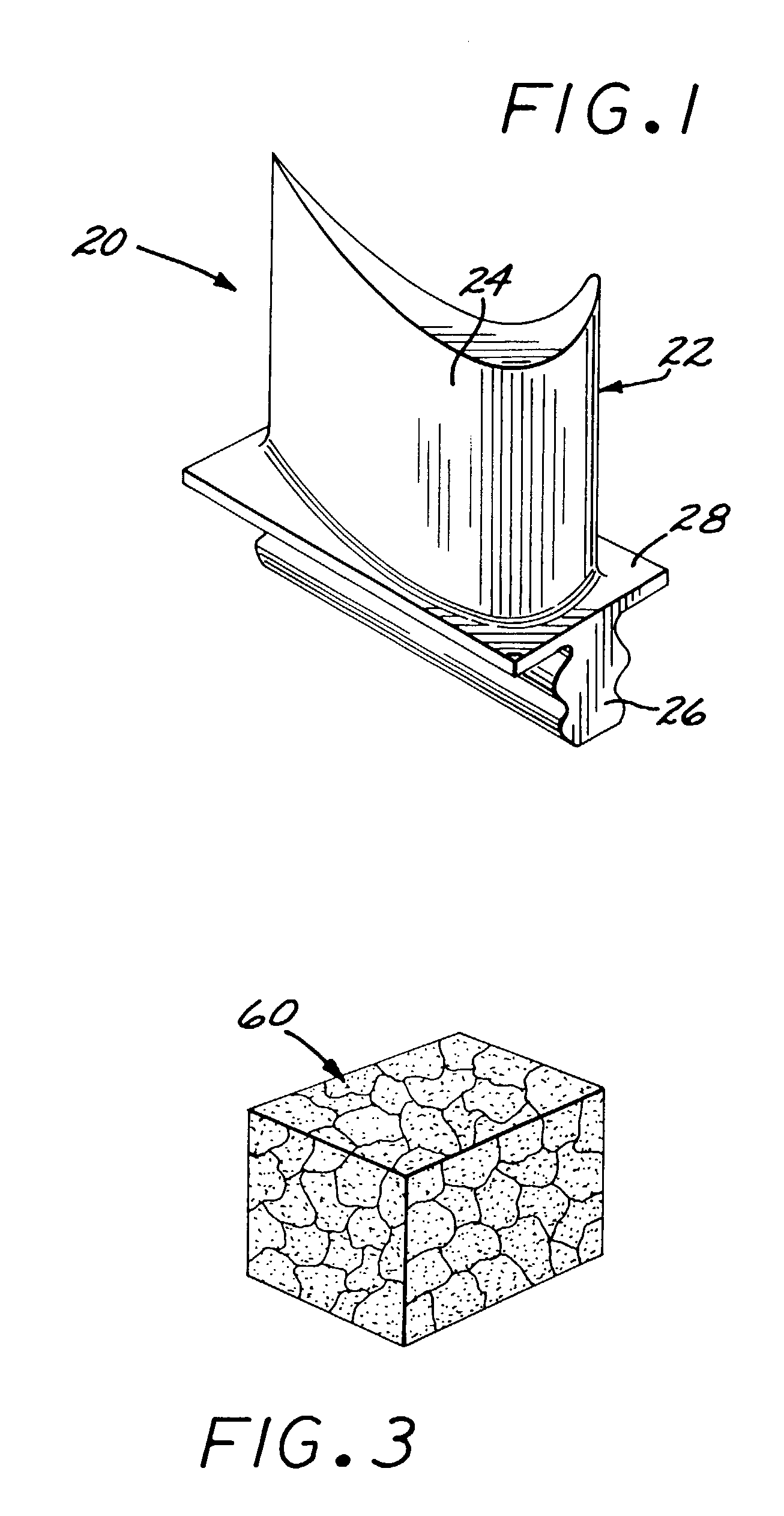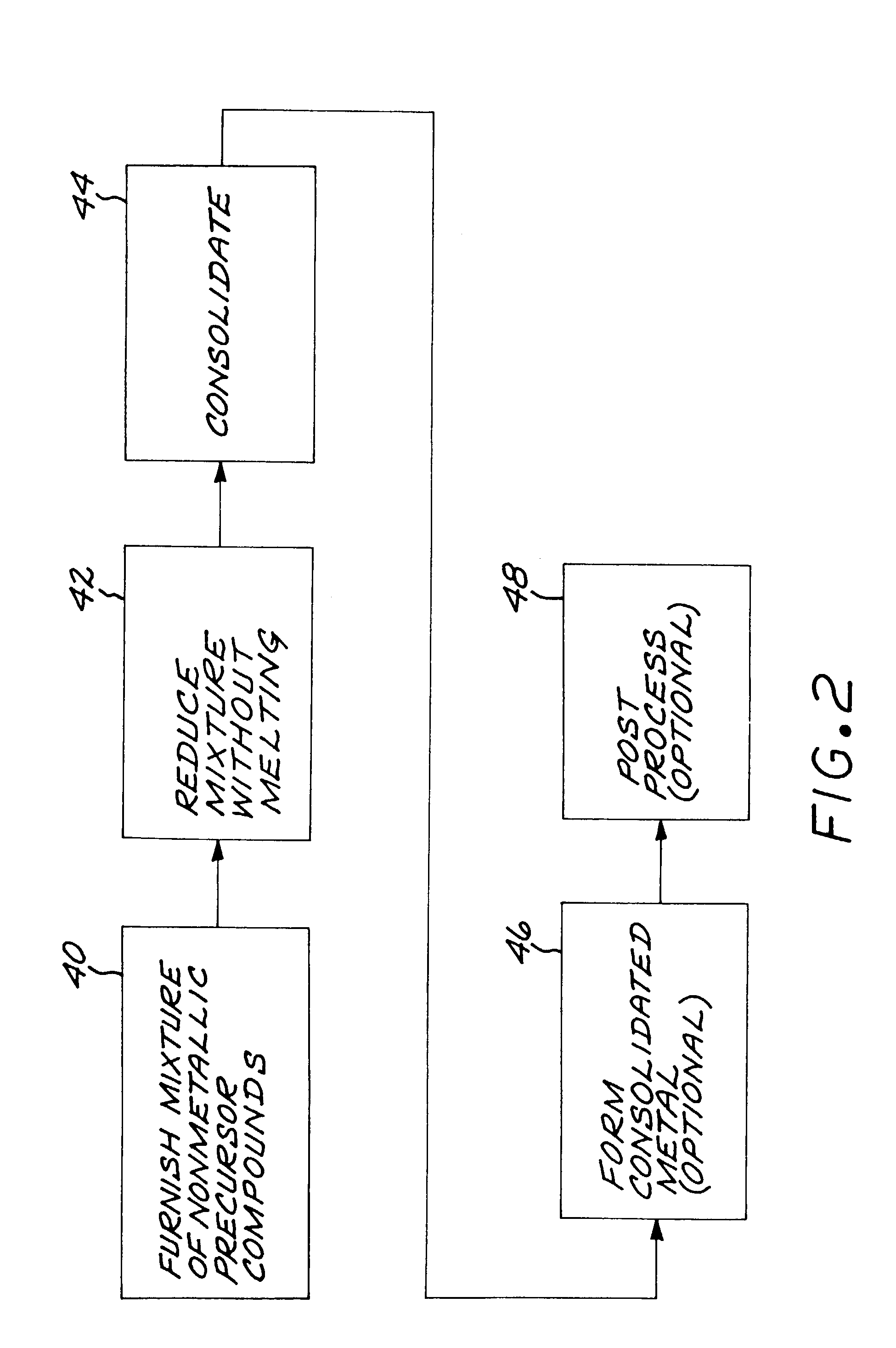[0018]The present approach differs from prior approaches in that the metal is not melted on a gross scale. Melting and its associated
processing such as
casting are expensive and also produce large-cast-grain-size microstructures and occasionally microstructures with local / long-range segregation such as eutectic nodules,
white spots, and freckles that either are unavoidable or can be altered only with additional expensive
processing modifications. Undesirable second phases which precipitate in the melt or during solidification of liquid, which are stable and cannot be dissolved in subsequent
solid state processing, are avoided. These second phases are a detriment to fatigue strength, and cannot be modified by subsequent processing. However, second phases may be introduced in a more-desirable dispersed form by the present meltless approach. The present approach reduces cost and avoids large grain sizes, detrimental coarse second phases, and defects associated with melting and
casting, to improve the mechanical properties of the final metallic article. It also results in some cases in an improved ability to fabricate specialized shapes and forms more readily, and to inspect those articles more readily.
[0019]The preferred form of the present approach also has the
advantage of being based in a
powder-like precursor. Producing a metallic
powder or
powder-based material such as a
sponge without melting avoids a cast structure with its associated defects. Those cast-structure defects can include elemental segregation (e.g., freckles,
white spots, and eutectic nodules) on a nonequilibrium microscopic and macroscopic level, a cast
microstructure with a range of grain sizes and morphologies that must be homogenized in some manner for many applications, gas
entrapment, and
contamination. The powder-based approach herein presented produces a uniform, fine-grained, homogeneous, pore-free, gas-pore-free, and low-
contamination final product.
[0020]The fine-
grain structure of the
sponge or powder superalloy material provides an excellent starting point for subsequent consolidation and
metalworking procedures such as
forging,
hot isostatic pressing, rolling, and
extrusion. The finer grain size aids workability because the material moves into a superplastic
working range. Conventional cast starting material must be extensively worked to modify and reduce the cast structure, and such extensive working is not necessary with the present approach.
[0021]Another important benefit of the present approach is improved inspectability as compared with cast-and-wrought product. Large metallic articles used in fracture-critical applications are inspected multiple times during and at the conclusion of the fabrication processing. Cast-and-wrought product made of metals and used in critical applications such as gas
turbine disks exhibits a high
noise level in ultrasonic inspection due to the
microstructure produced during melting,
casting, and processing. The presence of this
microstructure limits the ability to inspect for small defects.
[0022]The superalloy articles produced by the present approach are of a
fine grain size and are free of microstructures discussed previously that inhibit inspectability. As a result, they exhibit a significantly reduced
noise level during ultrasonic inspection, and permit inspection for smaller defects. The reduction in size of defects that may be detected allows larger articles to be fabricated and inspected, thus permitting more economical fabrication procedures to be adopted, and / or the detection of smaller defects. By reducing the
noise associated with the inspection procedure, larger
diameter intermediate-stage articles may be processed and inspected.
Processing steps and costs are reduced, and there is greater confidence in the inspected quality of the final product. The
resultant article that contains fewer and smaller defects also results in improved mechanical properties.
[0023]The present approach is advantageously applied to make superalloy articles (nickel-base articles,
cobalt-base articles, iron-base articles, iron-nickel-base articles, and iron-nickel-cobalt-base articles).
Contamination and other
impurity elements that are almost unavoidable in
conventional casting practice, and which may have major adverse effects on the properties of the material, may be eliminated with the present approach. The structure is more uniform and homogeneous than may be produced by
conventional casting and working techniques. For the material produced by the present approach that replaces conventionally cast material, there is a reduced incidence of defects such as those produced by segregation and inclusions (e.g.,
white spots, freckles, eutectic nodules, and banding) during
conventional casting operations, and those associated with remelted / recycled material. The cost is also reduced due to the
elimination of processing steps associated with casting. The reduction in the cost of the final product achieved by the present approach also makes the superalloys more economically competitive with otherwise much less-expensive materials such as low-cost ferritic and martensitic steels in cost-driven applications. Properties are also improved. Material made by the present approach that is a replacement for conventional wrought articles realizes these same benefits. Additionally, large-sized
specialty articles, whose size is limited only by compaction capability, may be made while avoiding microsegregation and macrosegregation. Reduced thermomechanical work is required to produce fine microstructures, and there is reduced loading on the mechanical working equipment. More complex processing may be used, because of the initially fine microstructure.
 Login to View More
Login to View More 

